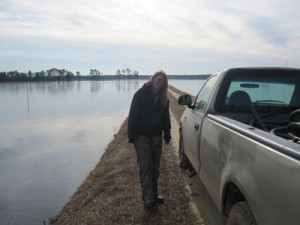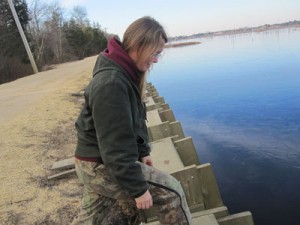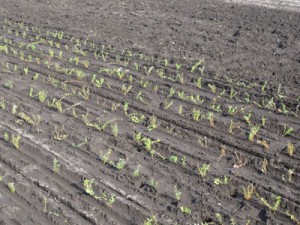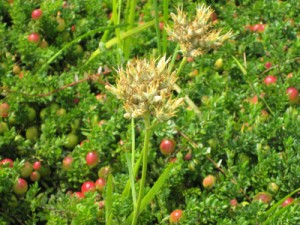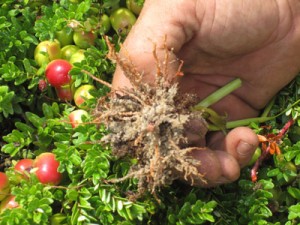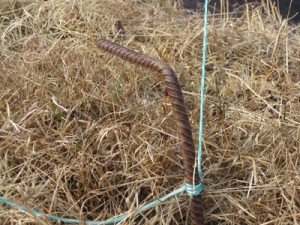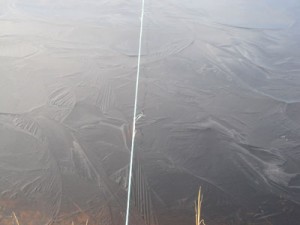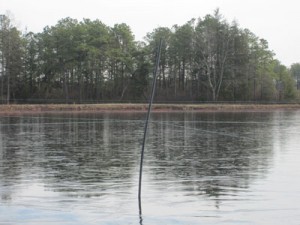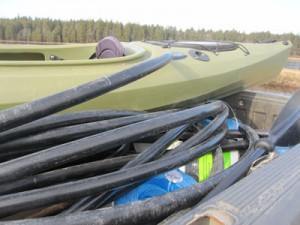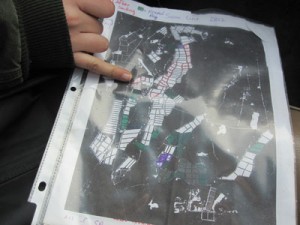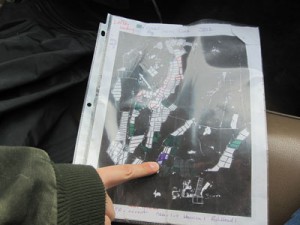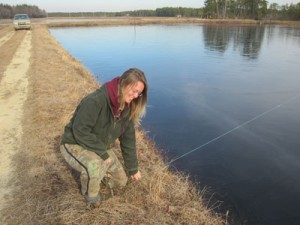For the new year, we’re focusing on a new face at Pine Island Cranberry: Kylie Naylor, our new Pine Island Integrated Crop Management (PIICM) supervisor. Kylie, a graduate of Delaware Valley College, earned her BS in agronomy in 2010. She’s from a farm family in the area and had previously scouted for blueberries, so she was familiar with both Pine Island and the work involved. “Cranberries are new for me, though!” she says.
Kylie came in at the end of October, just catching the tail end of the harvest. “It feels likes I’ve done a lot in a short amount of time,” she says. So far she’s worked with the fall planting, worked on underdrain repair, and is beginning to learn the basics of water management.
“I liked fall planting the best so far,” Kylie says. “You see it at the beginning, when there’s nothing there but the soil. . .and then you get to see the progression to a bog full of uprights. You get to see what you’ve accomplished.” The big project Kylie is currently working on: installing swan strings.
Tundra swans migrate to the area every year from Alaska and northwestern Canada. They are a tremendous annoyance to local growers due to their feeding habits. They are particularly fond of red root, a weed that competes with cranberry vines for nutrients. You might think that swans are a natural solution to the problem; unfortunately, when the swans fly in to feed, they not only tear out the red root, they also tear out vines and leave enormous holes that damage the beds themselves.
Since the swans are a protected species, growers have had to come up with a solution to keep them away from the crop. At Pine Island our PIICM team installs, or puts up, swan strings. To start, the team places rebar in the ground along the longer sides of a bog, about every 75 feet. On the ends of the bog, the team walks it out and determines how many lines they’ll need to run lengthwise though the center.
Once the rods are laid out on the dam, a team of three to five people gets into the bog and walks the string across. “We can the job done with three team members,” Kylie says, “but it’s much more efficient if you have five: you can have three in the water walking string and one person on each dam tying it off.”
Once the entire bog is strung, the team goes back in and puts up poles, which are used to keep the strings out of the water so that they don’t freeze. They’re placed in a checkered pattern, not necessarily on every line. The poles can either be cedar posts or recycled irrigation pipe. In addition to the recycling/environmental aspect, Kylie says that reusing the irrigation line is lighter and easier to handle, especially when the weather gets cold and the team starts using a kayak to place them.
The strings help keep the swans out of the bog by limiting the space available. “Swans are like a commercial airliner,” Bill says. “Having the strings up disrupts their attempt to both land and take off again.” Not all of the bogs are strung; our team maps them out where we have found red root and where the swans have been spotted. Kylie marks the map as she goes: the areas outlined in purple need to be done, the areas filled in with green are where she and her team have finished, and the areas outlined with red are where the sanding team is still working. Once sanding is finished, Kylie and her team will go string those particular bogs.
Swan strings are just one small part of the big picture that Kylie is slowly getting to know. Her biggest challenge, she says, is just learning the day-to-day business of cranberries. The process in general is fascinating to her, and she is enjoying figuring out how all the smaller parts that she is working on fit into the bigger picture. “Baby steps,” she says. “I like the challenge, though. I like coming in and learning how to do something new. And then I like figuring out ways to make it even better!”

